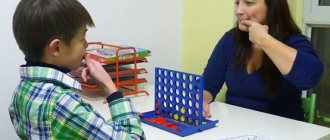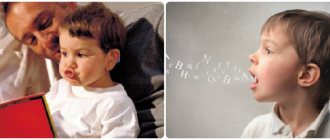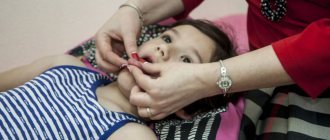Speech therapy classes at home. An article about how parents can organize classes at home and what exercises they can do on their own to develop speech and improve sound pronunciation.
The role of speech cannot be underestimated. It allows a person to express his thoughts and communicate with other people. Speech is the basis of interaction in society. Speech disorders prevent a child from expressing his thoughts and maintaining a conversation; they can lead to the appearance of complexes and affect school performance.
If you find sounds in your child’s speech that are not in their native language, or if you think that the child’s speech is not sufficiently developed for his age, you should immediately contact a speech therapist. The sooner a problem is detected, the faster and more effectively it can be corrected. As a rule, speech therapy classes are conducted with children starting from 3 years of age. But now a new direction has emerged - “speech therapy of early age”, focused on the prevention and correction of pre-speech and primary speech manifestations of deviant development in children under three years of age. At Children's there are speech therapists who work with children from 3 years of age, as well as speech therapists who specialize specifically in early childhood.
To achieve the maximum effect and help the child make his speech correct, competent and clear, it is not enough to send the child to a children's center, where a speech therapist will work with him. An equally important role is played by the child’s activities with his parents at home. The joint work of a speech therapist in classes and parents at home will be most effective. It is important that the speech therapist explains and shows parents not only what exercise to do at home with their child, but also how exactly to do it. After all, only a specialist knows the nuances of performing this or that exercise and the secrets that will help make the task or exercise as effective as possible for a particular child. In addition, no one has canceled the main rule of all doctors and teachers, “Do no harm.” And it is not so difficult to cause harm out of ignorance, for example, by fixing an incorrectly placed sound in speech. This often happens when parents try to produce the sound on their own. It won't be easy to fix this sound. Therefore, our Center welcomes the presence of parents in class - this helps parents understand exactly how to continue studying at home. But there are simple exercises that moms and dads can easily do with their baby on their own. These exercises will not harm the baby in any way, but, on the contrary, will strengthen his speech apparatus, motor skills and auditory attention, preparing him to pronounce difficult sounds.
General tips for practicing at home.
It is important that homework is not like lessons, but like a game. Come up with different stories to captivate your child. If you conduct classes in the form of games, your child will be more willing to learn to speak correctly, which will certainly help achieve great results in a short time.
Under no circumstances should you be angry if something doesn’t work out for your child! Correcting pronunciation is not easy; you cannot teach your child to pronounce all sounds clearly and clearly in one lesson, as well as to use complex words. In any activity, time plays an important role. Mistakes are an integral part of the learning process.
Be patient, praise your child even for the smallest successes, support him if something doesn’t work out. If you break down and scold your baby, then he will not speak better, but will only withdraw into himself, which can aggravate speech problems.
Classes must be regular. It is better to exercise 5 minutes a day than once a week for 1.5 hours. At the very beginning, you can start exercising with 3-5 minutes a day, gradually increasing them to 15-20 minutes twice a day.
Articulation gymnastics.
Articulation exercises play a huge role, because they contribute to the development of the speech apparatus, thanks to which children learn to control it and cope with the pronunciation of even complex sounds.
You need to do articulation gymnastics daily, 1-2 times a day for 3-5 minutes. All exercises should be performed without tension (the child sits quietly, the shoulders do not rise). Each exercise should be performed five times, each approach no longer than 5 seconds (counted by an adult). Add one new exercise per day, and if you find it difficult to perform an exercise, you need to return to a simpler one.
Basic set of articulation exercises:
- “Fence” - holding the lips in a smile, the front upper and lower teeth are exposed.
- “Tube” - stretching the lips forward in a tube (teeth closed).
- “Tube fence” - alternating the position of the lips in a smile and a tube.
- “Scapula” – holding a wide tongue on the lower lip in a calm, relaxed state.
- “Needle” - holding a narrow tongue between cuts.
- “Needle spatula” – alternating appropriate exercises.
- “Barrier” - raising the tongue by the upper teeth (the mouth is open, but not too wide).
- “Swing” - alternating upward and downward movements of the tongue while holding each position for five seconds.
- “Pancake” - holding the tongue behind the lower teeth in a calm, relaxed state.
- “Stretch” - stick out your tongue and stretch it to your nose, to your chin, to the right corner of your mouth and to the left.
It is recommended to perform articulation exercises in front of a mirror. Do the exercises with your child. It is better to buy a large mirror in which not only the child, but also you can be seen. In this case, the baby will be able to repeat all the actions. Since the best option is to exercise while sitting, it is better to purchase a tabletop mirror.
Recommendations “How to organize speech therapy classes at home”
Tatyana Chudaeva
Recommendations “How to organize speech therapy classes at home”
These recommendations are addressed to concerned parents who want to help their children overcome speech disorders as quickly as possible. Your child works with a speech therapist in kindergarten 2-3 times a week, depending on the speech diagnosis. Speech correction is a complex and lengthy process that requires significant effort from the speech therapist , the child and the parents. To develop the skill of correct pronunciation of sounds, it is necessary to repeat syllables, words, sentences and texts with these sounds countless times. There is no such opportunity in kindergarten. Therefore, if parents do not consolidate the acquired skills at home , the elimination of deficiencies is delayed, speech disorders become chronic and lead in the future to school failure.
I would like to emphasize that you, parents, are your child's first and most important teachers. His first school - your home - will have a huge impact on what he considers important in life, on the formation of his value system.
No matter how long we live, we still constantly return to the experience of childhood - to life in the family. The emotional attitude towards life and people laid down at this time and the presence or absence of incentives for intellectual development leave an indelible mark on all subsequent behavior and way of thinking of a person. The ability to speak, listen, and use language are also among the things that a child living among people learns very early.
For parents to become good teachers for their children, they must know that the work of correcting deficiencies in the pronunciation of sounds includes three main stages: preparatory exercises; setting (calling)
sound; fixing sound in syllables, words and introducing it into speech.
Preparatory exercises are aimed at developing in the child the correct perception of sound by ear (the ability to distinguish a correctly pronounced sound from an incorrect one, to strengthen and improve the movements of the muscles of the articulatory apparatus (reproducing the correct movements of the tongue, lips, lower jaw, to produce a strong air stream (for example, when pronouncing sound [p], you need to be able to blow air strongly onto the tip of your tongue to bring it into a vibrating state).
The better the preparatory work is done, the faster the child will learn to pronounce sounds correctly. It is difficult to say how much time will be needed for the preparatory exercises. In some cases - three lessons , in others - several weeks. This depends on the degree of impairment of the mobility of the muscles of the articulatory apparatus, on the state of speech hearing, as well as on the individual characteristics of the child.
Staging (calling)
sound is the task
of a speech therapist . But sometimes, with a simple violation, parents succeed. In order to evoke the correct sound in a child, it is necessary to carefully study the position organs during normal pronunciation of the sound and the methods of producing it. To do this, sit at the table, place a mirror in front of you and, while pronouncing the most difficult sounds (hissing, whistling, sonorous, carefully look at the position of your lips, teeth, tongue. Remember this position. This is important for correcting the defect, for producing the sound. Then sit the child in front of the mirror and ask him to pronounce this or that sound. Take a closer look at what position his speech organs , compare with the position and movement of the speech organs in your own . Now the main task is to achieve the correct isolated pronunciation of the sound. If you can cause sound by imitation, then, bypassing the preparatory stage, you can immediately begin to consolidate the sound in words and speech. If the sound does not work, do not be zealous, otherwise you can only consolidate the incorrect pronunciation. Perform the preparatory exercises, and the speech therapist .
Sound reinforcement and introduction it into speech.When fixing a sound, it is necessary to follow a certain sequence. First, the sound is fixed in syllables, then in words, and only then in phrases.
Let us dwell in more detail on the first stage of work to correct deficiencies in the pronunciation of sounds.
Even the most careful work of a kindergarten does not exclude the need to help children who incorrectly pronounce one or another group of sounds in the family.
By performing certain targeted exercises at home a speech therapist , parents help prepare the child’s articulatory apparatus to correctly pronounce those sounds that he does not pronounce well.
An important role in the formation of the pronunciation of sounds is played by the clear, precise, coordinated work of the articulatory apparatus (lips, tongue, lower jaw, soft palate)
.
To develop full movements of the lips, tongue, and jaw, as already mentioned, articulatory gymnastics is useful.
Various exercises help:
• production of a targeted air stream;
• relaxation of the tongue muscles;
• the ability to hold the tongue in a calm, relaxed position;
• strengthening the muscles of the tongue;
• lifting the tongue muscles upward;
• development of raising the back of the tongue upward, etc.
You need to do articulation gymnastics with your child for a few minutes every day.
Articulation gymnastics is performed standing or sitting in front of a mirror.
The pace and number of exercises gradually increases. These exercises are performed with counting, clapping, and music.
When working at home with children , parents should remember:
1. You cannot force a child. Classes will be effective if they are conducted in the form of a game.
2. You should move on to subsequent exercises only after mastering the previous ones.
3. All exercises must be performed naturally, without coercion.
4. Some exercises are performed using a count kept by adults. This is necessary so that the child develops the most important stability of the positions of the lips and tongue.
5. When carrying out exercises, the child may not always succeed in everything, and this sometimes causes refusal to further work. In this case, parents should not fixate the child on the fact that he can’t do it; they need to encourage the child, return to a simpler exercise, pointing out that it didn’t work out before, but now he has already learned.
6. For all questions that arise, be sure to consult with a speech therapist or teacher.
Classes should be held in a playful way, because this is the main activity of children. You can use your favorite toy: “let’s show the bunny how to properly perform gymnastics for the tongue.”
It is best to carry out articulatory gymnastics in the form of a fairy tale, based on a picture-image.
THE TALE OF THE Merry Tongue
(a set of exercises that develops the correct articulatory structure of the sounds SH-ZH-SHCH.)
Once upon a time there was a Merry Tongue. He had a house. This is the mouth. To prevent Merry Tongue from running out, his house was always closed. There are two doors in the house.
The first door is the lips. Let's open it (exercise "Frogs"
).
The second door is teeth. Let’s open it too (exercise “Window”
)
What does our Tongue do? He's sleeping. It has a soft pillow - your lip (exercise “Spatula”
)
Look how sweetly and calmly the tongue sleeps (hold your tongue on your lower lip for a while)
.
Finally he woke up, smiled (exercise “Smile”
, took the trumpet and played
“Tut-tu, I woke up!”
(exercise
“Pipe”
).
Tongue went to the kitchen, and there mom was kneading the dough “Five-five”
(exercise
“Knead the dough”
) and bakes pancakes (exercise
“Pancake”
).
Tongue took a cup of tea (exercise “Cup”
, jam, bagels (exercise
“Bagel”
) and began to have breakfast. But he didn’t eat carefully and stained his upper lip with jam (exercise
“Tasty Jam”
). After eating, Tongue decided to show his mother the real one. focus (exercise
"Focus"
).
Tongue wanted to take a walk. He went out into the yard and saw a swing. I decided to go for a ride (exercise “Swing”
).
Then our tongue saw a horse and he wanted to ride it. It was fun for him to ride a horse (exercise “Horse”
)
Tongue had a walk and went home. First he closed the second door - his teeth, and then the first - his lips (close his lips)
.
The ability to focus on sound is a very important human characteristic. Without it, it is impossible to learn to listen and understand speech - the main means of communication. It is also important to distinguish, analyze and differentiate by ear phonemes (the sounds that make up our speech)
. This skill is called phonemic awareness.
A small child does not know how to control his hearing and cannot compare sounds. But a child can be taught this. It is especially necessary to develop auditory attention and phonemic hearing for children with speech problems. Sometimes a child simply does not notice that he is pronouncing sounds incorrectly.
The purpose of our exercises is to teach the child to listen and hear. You will soon notice that the child has begun to hear himself, his speech, that he is trying to find the correct articulation of sound and correct defective pronunciation.
The goal of all these games is to develop auditory attention (concentration, stability, switching)
.
Games for the development of phonemic awareness are recommended for children over 3 years of age. Good phonemic hearing is necessary for a child to master the sound system of the language and for competent oral and written speech.
From the cradle, a baby is taught to respond to intonation, rhythm and sound of words. Already at the end of the first year of life, the child notices differences in the sound of words. He begins to distinguish some speech sounds from others, and tries to pronounce them correctly. By the end of the second year, he distinguishes all the sounds of his native language and can notice defective pronunciation of sounds in the words of his peers, and tries to correct them. The phonemic distinction of sounds becomes available to him. Every child makes this journey in mastering the sound side of a word. To compensate for the delay in the child’s speech development, this path should not be carried out spontaneously. An adult must come to the child’s aid in a timely manner and purposefully guide the development of his speech activity. All this is necessary for a child without deviations in speech development, because a conscious attitude towards language is the basis for mastering all aspects of the language (phonetic, lexical, grammatical)
and forms of speech
(dialogical and monological)
.
The recommended exercises help the child master the sound system of his native language and prepare the child for mastering literacy and written speech.
1. Game for distinguishing non-speech sounds, developing auditory attention and auditory memory “Guess what it sounds like”
.
Equipment: screen, various toys and objects that can be used to produce characteristic sounds: bell, tambourine, drum, paper, foil, pipe, rattle, rattle, etc.
Move. An adult behind a screen rings a tambourine, rustles paper, rings a bell, etc. and invites the child to guess what object produced the sound. The sounds must be clear and contrasting so that the child can guess them. Instead of a screen, you can invite the child to simply sit with his back to the adult.
2. A game to distinguish identical words, sound complexes and sounds, focusing on the height, strength and timbre of the voice “Guess who is screaming”
Equipment: toys or pictures depicting domestic animals : cow, dog, cat, horse, etc.
Move. The adult shows the child prepared pictures or toys and plays with them, imitating the cry of the corresponding animals. Then he asks the child to listen and guess who will come to visit them. An adult covers his mouth with a piece of paper and makes a voice, imitating one of the animals. The child guesses who it is. The game can be repeated 5-6 times. It is necessary to ensure that the baby listens carefully and activate him with questions.
3. Word recognition game “Magic Wand”
Equipment: an item that can act as a magic wand (laser pointer, pencil wrapped in foil, etc.)
.
Move. An adult and a child examine objects in the room. An adult has a magic wand in his hand, with which he touches an object and names it loudly. Following this, the child pronounces the name of the object, trying to make it as clear as possible. The adult constantly draws the child’s attention to the fact that they are pronouncing words. It is necessary to ensure that the child correctly correlates words with objects.
A child's mind is at his fingertips. (V. A. Sukhomlinsky)
Research by scientists from the Institute of Physiology of Children and Adolescents of the Academy of Sciences (M. M. Koltsova, E. A. Isenina, L. V. Antakova-Fomina)
the connection between intellectual development and finger motor skills was confirmed. The level of development of children is also directly dependent on the degree of formation of fine hand movements. To determine the level of speech development of children in the first years of life, the following method has been developed: the child is asked to show one finger, two and three. Children who are able to make isolated finger movements are talking children. If the movements are tense, the fingers bend and straighten only together and cannot move in isolation, then these are not speaking children.
Speech and motor zones are located next to each other, so “by irritating one, the other is improved”
Since there is a close relationship and interdependence of speech and motor activity, if a child has a speech defect, special attention must be paid to training his fingers.
You can train your fingers as early as 6 months of age. The simplest method is massage: stroking the fingers in the direction from the fingertips to the wrist.
The hedgehog stomped along the path
And he carried mushrooms in a basket.
To count the mushrooms,
You need to bend your fingers.
Children bend their fingers one by one, doing a massage, first on the left, then on the right hand. At the end of the exercise, the child’s hands should be clenched into fists.
I wish you success in your studies and joy in communication!
Exercises with special literature.
Currently, the range of teaching aids is huge. When choosing, you need to focus on publications with bright illustrations; they attract attention and maintain the child’s interest.
If your baby pronounces all the sounds, but has difficulty coordinating words and retelling or has a poor vocabulary, then give preference to literature: N.V. Nishcheva “Teaching children storytelling based on pictures”, N.E. Teremkova “I am learning to retell”, N.E. Teremkov “Speech therapy homework for children 5-7 years old with OHP”, O.A. Novikovskaya “Speech Pediatric Grammar”.
Exercises to develop fine motor skills.
The level of development of a child’s speech is directly related to the development of fine motor skills. Even ordinary plasticine will be an effective tool for training it. It is enough for kids to knead this material and sculpt simple one-color shapes. With older children, learn to make more complex multi-colored figures, for example, different animals.
Explore colors and shapes while playing with clay.
You can make several figures and come up with a story for them, in this case the child will develop his imagination and increase his vocabulary. For example, a story about going to a grocery store - you can make fruits and vegetables, put them on the “counter” and play seller and buyer. Thanks to this game, the child will expand his vocabulary, remembering the names of vegetables and fruits, and will be able to repeat colors and shapes.
Here are a few more ideas and techniques on how to develop your baby’s motor skills:
* Buy a su-jok ball, which consists of two parts: a spiky ball and a spring. Place the spring on your fingers one at a time, saying nursery rhymes or simply naming your fingers, and roll the ball over the baby’s palms and fingers.
* Compete in pulling ribbons, strings, pencils, and laces with your fingers.
* Wrap small objects in foil and let your baby unwrap them.
* Let the child in the summer, on the way from the dacha, pick off one petal from a chamomile.
* Let the bubbles press on the bubble wrap.
* Allow your child to fasten and unfasten buttons himself, unscrew and tighten the caps of plastic bottles.
*Give a bowl of mixed peas and beans or smaller grains to make it more challenging - ask your child to sort.
* Give your child small objects and ask them to put them one at a time into a plastic bottle through the neck. A variant of the game at sea is collecting small pebbles in a bottle. This game also teaches the baby to determine the size of objects by eye.
* Let the child wrap the ribbon around a stick or finger.
* Play with clothespins! Let the child hang out the doll's clothes to dry. And if you attach clothespins to a yellow circle cut out of cardboard, you will get a sun!
The game “Who Eats What” should be in the arsenal of both specialists and mothers. This game implements a large number of pedagogical tasks, and most importantly, it is attractive and interesting for children (and adults too). You can practice grammar, vocabulary, and automate naughty sounds. This game is also useful for non-speaking children: using the correct game instructions, an adult can stimulate the child’s speech activity.
* It is very useful to do appliqué. The hand movements that are involved in cutting using scissors are very good not only for fine motor skills, but also for excellent brain development. It will be useful to make an application and come up with a story about it. For example, when making an applique of a dragonfly, invite your child to come up with a story about it. Help your child by asking him guiding questions:
What is your dragonfly's name? What is she like? What does she like doing? Where did she fly? Who did you meet?
Here's an example of a story that might come out:
"Dragonfly Fun"
Once upon a time there lived a dragonfly. Her name was Zabava. She was multi-colored and her wings shimmered in the sun with all the colors of the rainbow. One day, a dragonfly flew to hunt a pond. She dreamed of catching a fatter mosquito. Above the pond she saw a fat, very fat mosquito flying over the water and cheerfully singing a song: zu-zu-zuuuu, zu-zu-zuuuu, I don’t fight the dragonfly!
The dragonfly, Fun, liked the song so much that she changed her mind about catching a mosquito and decided to make friends with it. She flew up to the mosquito and began to sing along with it: za-za-zaaaa, za-za-zaaaa - I’m a big dragonfly. Thus began the first ever friendship between a dragonfly and a mosquito.
Such an application will contribute not only to the development of motor skills, but also imagination, coherent speech, strengthen good relationships with adults, elevate mood, and will also help to consolidate the sound [Z] in speech if this sound is at the stage of automation.
Speech pathologist-defectologist
At the first lesson, a speech pathologist-defectologist diagnoses the current level of speech development of the child, based on the results of which he conducts a consultation with parents and draws up an individual plan for further correctional classes. Depending on the identified disorders, the specialist includes speech therapy massage, articulation and finger exercises, logorhythmics, and play therapy in speech therapy sessions. There are certain AGE STANDARDS FOR SPEECH DEVELOPMENT
:
Preparatory stage (from 0 to 1 year):
First, humming appears, and after 5 months - babbling. Sound complexes such as “cha-cha”, “dya-dya”, “me-me”, “ba-ba”, “da-da”, “ma-ma”, “pa-pa” appear. All children begin to babble, but, unfortunately, not all children turn into babbling. By one year, the baby utters the first words, such as “give” - a demand to receive something. Or “mom”, “dad”.
Pre-school stage (from 1 year to 3 years):
End of the first year – children use 5-10 words. In the second or third year of life, a significant accumulation of vocabulary occurs. By one and a half years the child uses 10-20 words, by two - 20-40 words, by two and a half - 200 - 400 words, by the third year 1000 - 1500 words. At this stage, the grammatical structure of speech begins to actively form. After one and a half years, phrasal speech appears, which includes simple sentences. For example, “Papa, di” - Dad, go. Children already use three- and four-word sentences with partial grammatical forms at two to three years old.
Preschool stage (from 3 to 7 years):
By the age of four - five years, a child’s active vocabulary reaches 3,000 - 5,000 words, and by the age of seven it can reach 10 thousand words. By the age of 3-4 years, a child should distinguish and name parts of objects and their characteristics (color, shape, size), and know short rhymes. By the age of five, all parts of speech are actively used. The child understands general words (transport, clothing, etc.), understands the meaning of what he read and can repeat it. Also, the child should already have all the sounds of speech, with the exception of the sound “r”, which may appear a little later. Thus, by the end of the preschool period, children should have developed phrasal speech that is correctly formed phonetically, lexically, and grammatically.
It is important to understand that any difficulties in a child’s speech development that are not eliminated in a timely manner have a negative impact on the formation of his basic mental processes and psycho-emotional state in general. A child’s thinking develops through speech, so even in cases where intelligence is preserved, but there is no speech, mental development begins to be delayed.
If you notice any, even minor, disturbances in your child’s speech development, this is a reason to consult with a children’s speech pathologist.
Proper speech development is the foundation for further successful schooling and the formation of a harmonious personality!










